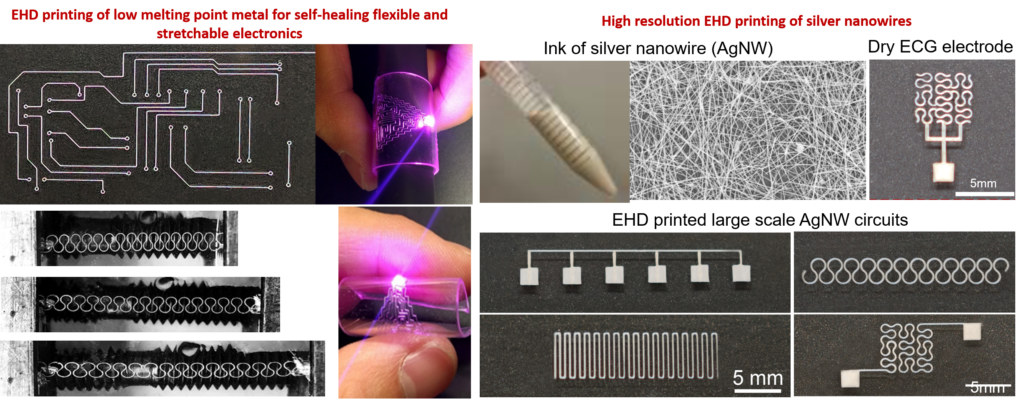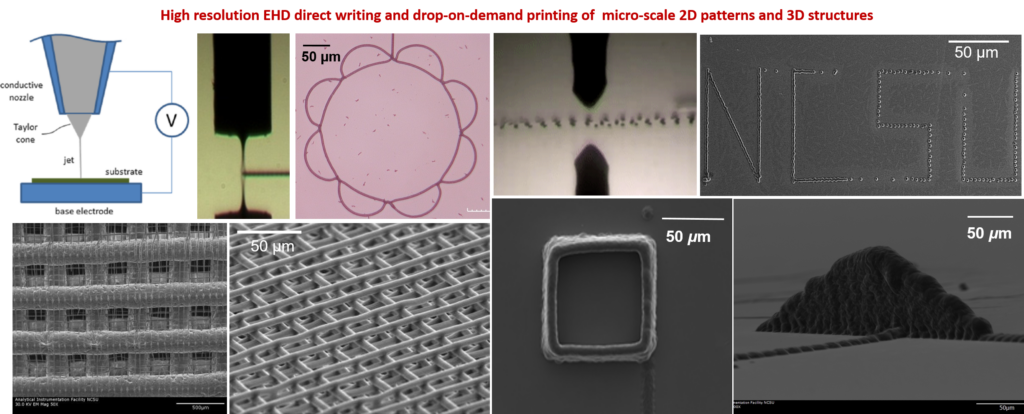Research
Research
The research in Dr. Dong’s group focuses on the innovation of novel manufacturing processes and manufacturing systems for advanced Micro/Nanomanufacturing applications. Following research directions are currently pursued by the group:
Integrated printing of flexible and stretchable electronics
We developed electrohydrodynamic (EHD) printing processes to many functional materials, including silver nanoparticle ink and ZnO nanoparticle-based suspension. The drop-on-demand printing mode was developed to print micro-droplets for these functional inks. The droplet dimension and ejection frequency can be precisely controlled by regulating the printing parameters. Electrodes and interconnects were successfully fabricated using silver nanoink. Sub-5µm feature resolution was routinely obtained. Recently we explored EHD printing for a few traditionally hard-to-print materials, including 1D nanomaterials (e.g., AgNWs) and molten metal alloys, for the fabrication of 2D circuity and flexible and stretchable electronics. An AgNW ink was designed by mixing and suspending AgNWs into PEO solution. AgNW conductors were printed with about 50µm linewidth routinely, which is far beyond the capability of the existing nanowire processing approaches. We also developed an EHD printing process for the molten metal inks that is hard to print due to the extremely high surface tension. The low melting point metal alloys (e.g., fields metal, wood metal, and solder) were successfully printed with much higher resolution than traditional extrusion printing method.
Direct EHD-jet fabrication of high resolution (sub-10µm) 3D structures and scaffolds
We develop a direct three-dimensional (3D) fabrication of polymer scaffolds with sub-10 µm structures using electrohydrodynamic jet (EHD-jet) plotting of melted thermoplastic polymers. Traditional extrusion-based fabrication approaches of 3D periodic porous structures are very limited in their resolution, due to the excessive pressure requirement for extruding high-viscous thermoplastic polymers. we successfully apply electrohydrodynamic jet (EHD-jet) plotting technology with melted biodegradable polymer (polycaprolactone, or PCL) for the fabrication of 2D patterns and 3D periodic porous scaffold structures in potential tissue engineering applications. We have demonstrated for the first time that the EHD-jet plotting process is capable of the fabrication of 3D periodic structures with sub-5µm resolution. The achieved filament diameter is one to two orders of magnitude smaller than traditional melt extrusion based fabrication approaches. The EHD-jet plotted micro-scale structures have great potential in advanced biomedical applications, such as cell alignment and guidance of cell growth.
Modeling and data driven machine learning for monitoring the nanomachining process
We modeled the vibration-assisted nanomachining process by studying the relationship between the structural dimension and the machining parameters. Semi-empirical regression models were built to predict the structure dimension in nanomachining and provide instructions for the selection of machining parameters. We also studied the mechanism of the nanomachining process to predict the resulting machining force. A semi-empirical machining force model was built by correlating the machining force with the input process parameters, which was verified by experiments over a large range of machining conditions.
Tip wear can significantly affect the machining performance and the resulting structure dimension. We characterized and modeled the evolvement of the tip wear and tip life for the nanomachining process. Time-series data analysis and pattern recognition using a multi-class support vector machine (SVM) were studied to monitor the state changes of the AFM tip-based nanomachining with respect to the machining performance and tip wear. Using the time-series data of machining forces collected by process sensors, a few features including the maximum force, peak-to-peak force, and the variance of the lateral machining force, were extracted to classify the states of the nanomachining process. The Directed Acyclic Graph SVM and Incremental Adaptive SVM were constructed to monitor process status online with a high accuracy over 95%. The unsupervised gaussian mixture model was also studied for online process monitoring with much shorter calculation time but slightly lower classification accuracy.
High rate nanofabrication with Atomic Force Microscopy
In this research, we investigate a low cost, high speed, tunable nanomachining approach using sharp cantilever tips with the help of ultrasonic vibration. The controllable ultrasonic vibration between the tip and the sample enables tunable fabrication of features across a wide dimensional range in one pass with high efficiency. The ultrasonic z-vibration of the sample provide a reliable method to regulate fabrication depth, as the ultrasonic force mostly depends on the vibration amplitude and is insensitive to the oscillation frequency. A high-frequency in-plane circular vibration is introduced to control the width of the fabricated features, and to improve the speed of nanolithography. The lateral dimensions of the feature can be regulated by changing the amplitude of the circular motion. This research incorporates process innovation and process modeling (empirical models for analysis of the nanomachining process with respect to material, geometric and process parameters) to create a novel manufacturing process for high rate nanofabrication.
Modeling and optimization of nano-material synthesis
Nanowires, as one dimensional nanostructures, are important building block for many applications, such as electronic, opto-electronic and nanoelectromechanical devices. Our group is working on the optimization of the growth process of semiconductor nanowires (NWs) by modeling the interrelationship between their growth process variables, structural defects, and mechanical properties, so that reliable NW-based devices with fewer defects can be produced.
Meso and MEMS scale devices for high-rate nanomanufacturing and bio-sensing
Nanopositioning systems with nanometer resolution and accuracy are critically important for nanotechnology. High natural frequency (open-loop bandwidth) is a critical requirement for nanopositioners in high-throughput nanomanufacturing and nanometrology. Dr. Dong’s group developed high-speed nanopositioners at the meso and MEMS scales to address applications in high-rate nanometrology, imaging and manufacturing. The developed system achieved high bandwidth while keeping parasitic motion as low as possible. Parallel kinematic mechanisms are designed and obtaining about 10KHz resonant frequency, 2kHz closed-loop bandwidth, 10’s of microns motion range and sub-nanometer resolution. Many MEMS-scale devices for nanomanufacturing and bio-sensing application were developed and fabricated, including MEMS-scale nano-positioning stages, micro probes for cellular force sensing, active cantilever devices for nanometrology and nanomanufacturing systems that are capable to be scale up for high-rate parallel processing.
